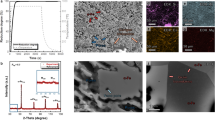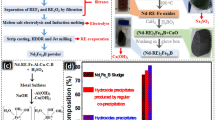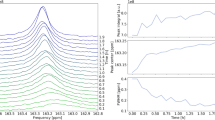Abstract
“IN 1872, US patent No. 133099 on the use of a magnetic coil for ‘Improvement in Reduction of Ores, etc.’ was granted to Abraham T. Hay, of Burlington, Iowa1. It was a failure.” Thus stated Skorski2 who a century later reported that the reduction rate of haematite (Fe2O3) with H2 was considerably enhanced by application of 500- and 1,400-oersted magnetic fields as compared with reduction in the Earth's field (∼0.5 oersted). Skorski2 also used CH4 and CO for the reduction, but found the rate in these cases was slower in a strong magnetic field than in the Earth's field. He concluded that the effect must be dependent on the magnetic properties of H2 itself rather than on those of Fe and its oxides. This notion was immediately challenged by Svare3 who demonstrated that the magnetic properties of H2 are not significantly different from those of CO and CH4 in the context of the reaction involved. Peters4, however, argued that the observed acceleration in reaction rate is predictable from thermodynamics theory when product and reactant species differ widely in their magnetic properties—as do Fe2O3 and metallic Fe (or NiO and metallic Ni) for example. One can readily view this argument qualitatively in terms of Le Chatelier's principle.
This is a preview of subscription content, access via your institution
Access options
Subscribe to this journal
Receive 51 print issues and online access
$199.00 per year
only $3.90 per issue
Buy this article
- Purchase on Springer Link
- Instant access to full article PDF
Prices may be subject to local taxes which are calculated during checkout
Similar content being viewed by others
References
Hay, A. T., US Patent No. 133099 (November 19, 1872).
Skorski, R., Nature phys. Sci., 240, 15 (1972).
Svare, I., Nature phys. Sci., 244, 78 (1973).
Peters, C. T., Nature phys. Sci., 244, 79 (1973).
Larson, E. E., Watson, D. E., Herndon, J. M., and Rowe, M. W., Earth planet. Sci. Lett., 21, 345 (1974); ibid., 27, 101 (1975); ibid., 29, 283 (1976).
Author information
Authors and Affiliations
Rights and permissions
About this article
Cite this article
ROWE, M., FANICK, R., JEWETT, D. et al. Effect of magnetic field on reduction of nickel oxide. Nature 263, 756–757 (1976). https://doi.org/10.1038/263756a0
Received:
Accepted:
Issue Date:
DOI: https://doi.org/10.1038/263756a0
This article is cited by
-
An evolved gas analysis study of the reduction of nickel oxide by hydrogen
Journal of Thermal Analysis (1982)
-
Curie temperature of alloys, its measurement and technical importance
Journal of Thermal Analysis (1982)
-
Effect of magnetic field on reduction of iron oxides: magnetite and wüstite
Nature (1977)
Comments
By submitting a comment you agree to abide by our Terms and Community Guidelines. If you find something abusive or that does not comply with our terms or guidelines please flag it as inappropriate.



